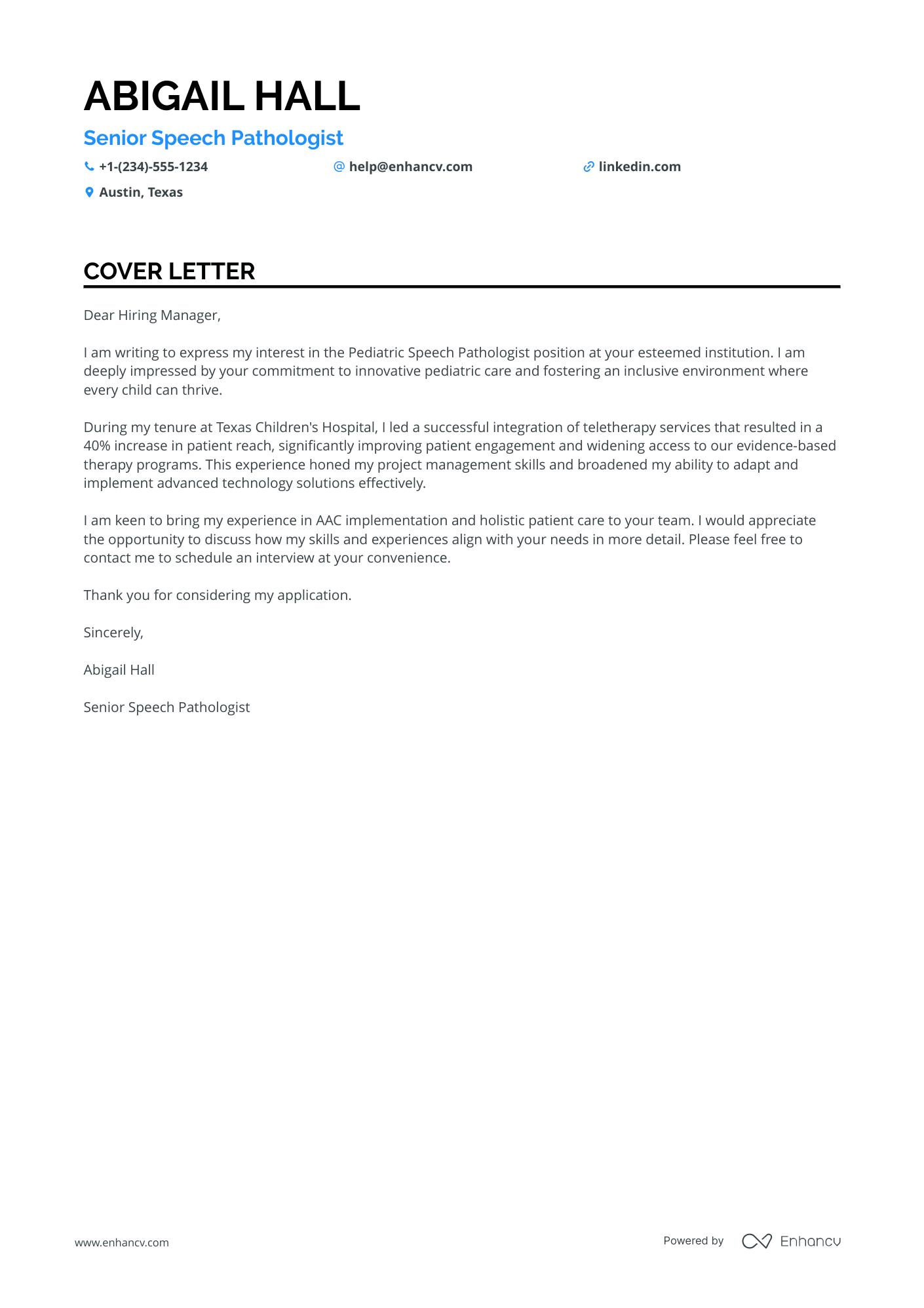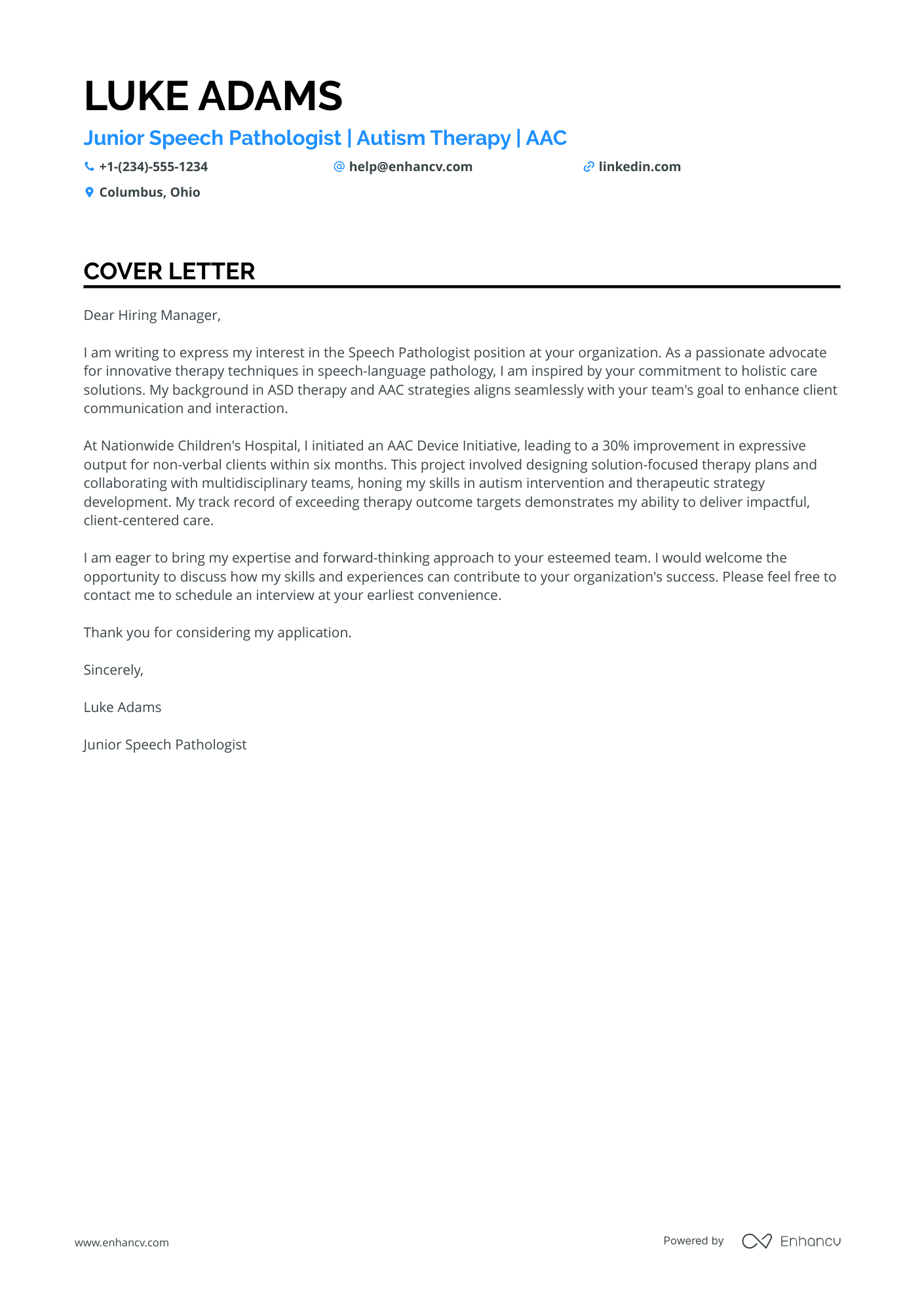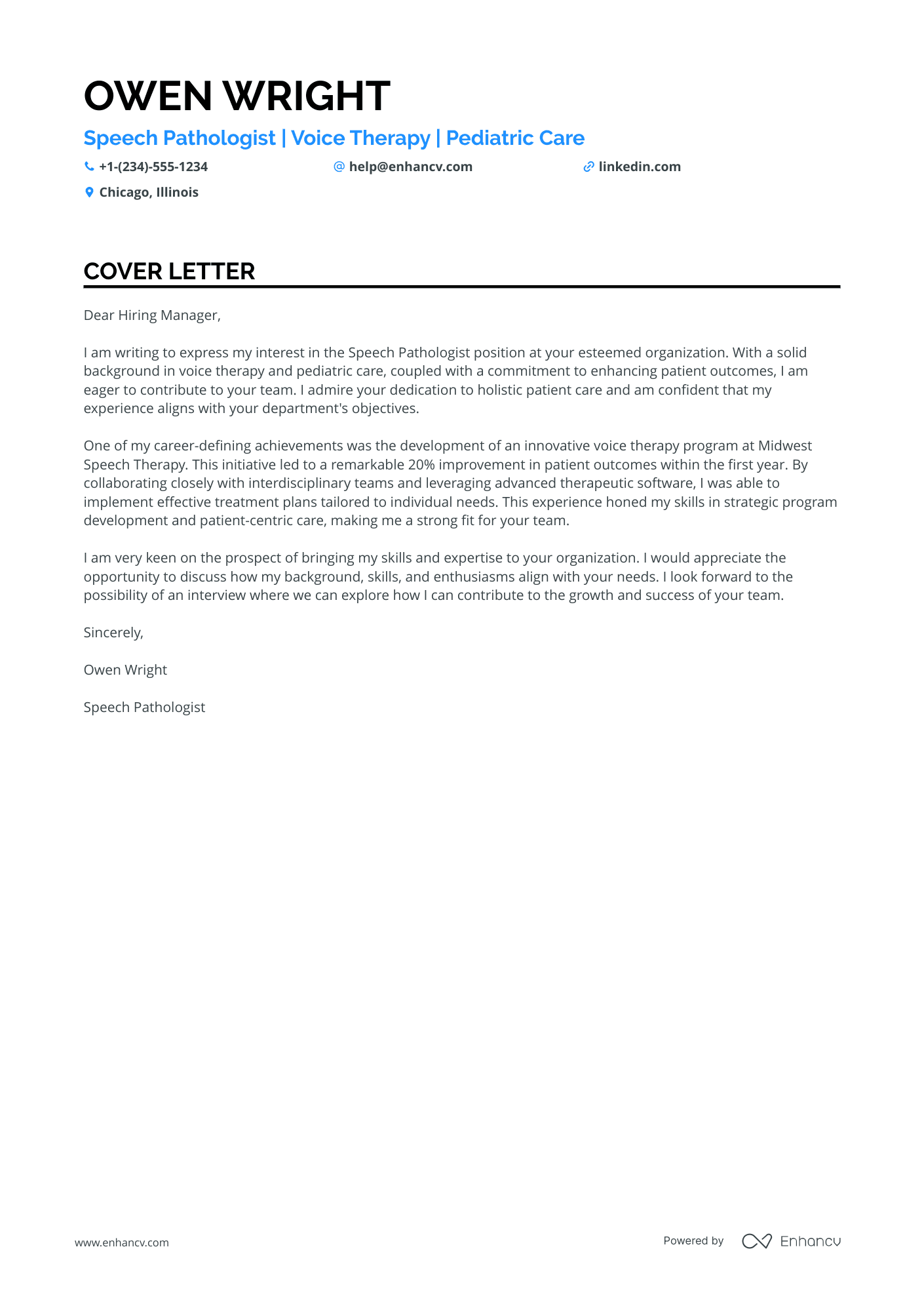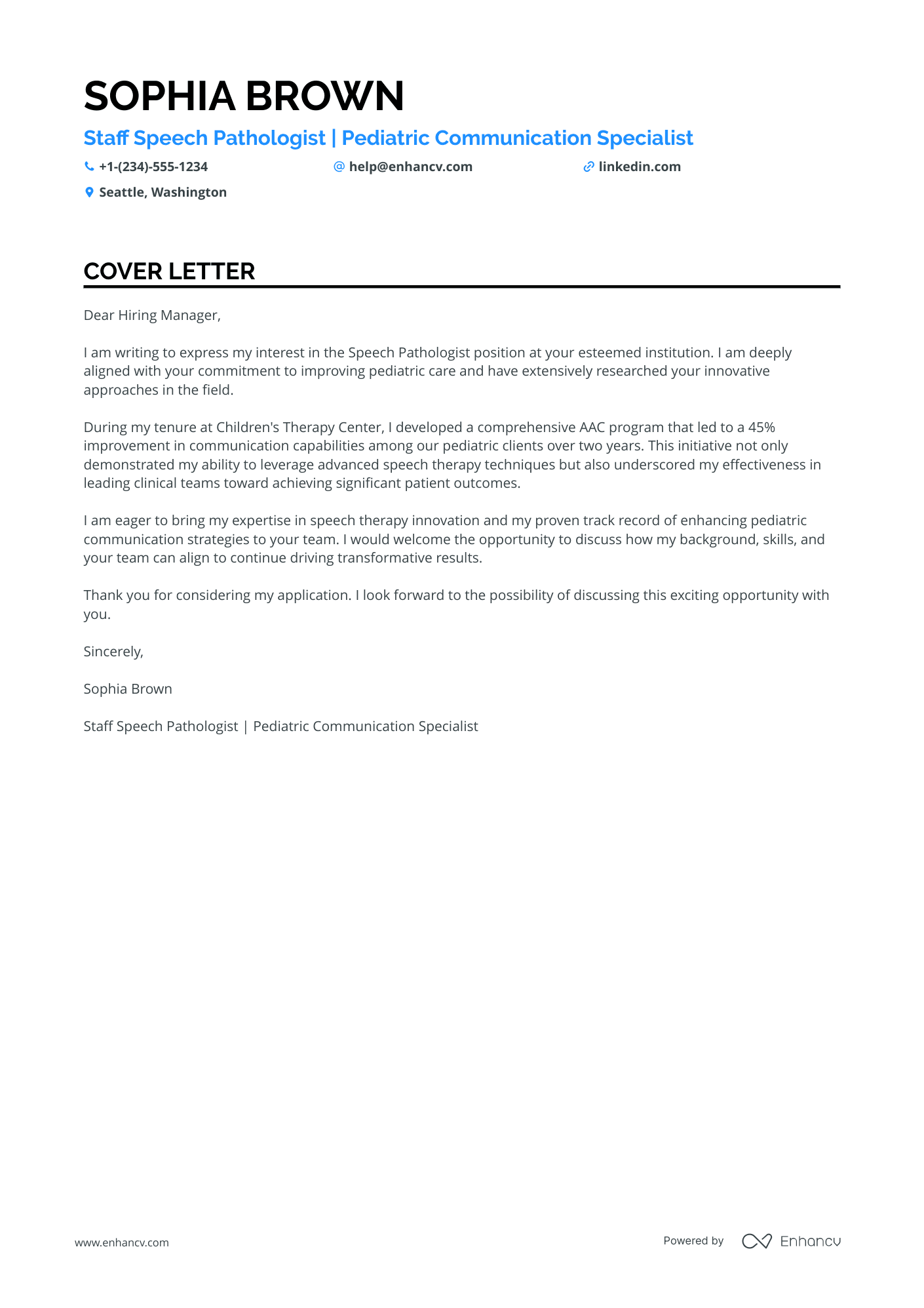Crafting a speech pathologist cover letter can be daunting, especially when you’re eager to land that dream job. You've polished your resume and now realize a compelling cover letter is your next step. Remember, it's not a resume rerun but a chance to spotlight a proud professional moment in a narrative form. Aim for a blend of formality and originality, steering clear of clichés, and keeping it concise—the sweet spot is just one page. Let's dive in.
- Writing the essential speech pathologist cover letter sections: balancing your professionalism and personality;
- Mixing storytelling, your unique skill set, and your greatest achievement;
- Providing relevant (and interesting) information with your speech pathologist cover letter, despite your lack of professional experience;
- Finding the perfect format for your[ speech pathologist cover letter, using templates from industry experts.
Leverage the power of Enhancv's AI: upload your resume and our platform will map out how your speech pathologist cover letter should look, in mere moments.
If the speech pathologist isn't exactly the one you're looking for we have a plethora of cover letter examples for jobs like this one:
Drop your resume here or choose a file.
PDF & DOCX only. Max 2MB file size.
Speech pathologist cover letter example
Andrew Green
Austin, Texas
+1-(234)-555-1234
help@enhancv.com
- Aligning with the organization's mission: The cover letter starts with a direct connection to the organization's values which shows the candidate's alignment and commitment to similar goals, making them a potentially good cultural fit.
- Quantifiable achievements: The inclusion of specific results (e.g., "overall improvement in patient communication abilities by 30%") provides concrete evidence of the candidate's impact in previous roles, showcasing their ability to deliver measurable outcomes.
- Expertise in relevant technology: Mentioning the development and implementation of an AAC system demonstrates the candidate's technical skills, which is a critical aspect for a Speech Pathologist utilizing assistive technology.
- Call to action: The candidate closes the letter by inviting the hiring manager to discuss how their experience aligns with the organization's goals, demonstrating proactivity and interest in engaging further.
Standard formatting for your speech pathologist cover letter
Structure your speech pathologist cover letter, following industry-leading advice, to include:
- Header - with your name, the role you're applying for, the date, and contact details;
- Greeting - make sure it's personalized to the organization;
- Introduction paragraph - no more than two sentences;
- Body paragraph - answering why you're the best candidate for the role;
- Closing paragraph - ending with a promise or a call to action;
- Signature - now that's optional.
Set up your speech pathologist cover letter for success with our templates that are all single-spaced and have a one-inch margin all around.
Use the same font for your speech pathologist cover as the one in your resume(remember to select a modern, Applicant Tracker System or ATS favorites, like Raleway, Volkhov, or Chivo instead of the worn-out Times New Roman).
Speaking of the ATS, did you know that it doesn't scan or assess your cover letter? This document is solely for the recruiters.
Our builder allows you to export your speech pathologist cover letter in the best format out there: that is, PDF (this format keeps your information intact).
Cut down the time spent on cover letters. Use our free cover letter generator to create one in seconds.
The top sections on a speech pathologist cover letter
- Header: This section includes your contact information, the date, and the employer's contact information, ensuring the letter is addressed properly and can be filed or responded to accordingly.
- Greeting: Personalize the greeting by addressing the hiring manager by name, showing attention to detail and a personal touch, which is critical for a profession that values interpersonal communication skills.
- Introduction: Introduce yourself with a brief mention of your qualifications and express your enthusiasm for the speech pathology field, demonstrating your genuine interest and commitment to the role.
- Body: Highlight specific experiences or successes in speech pathology, such as particular techniques or therapies you are proficient in, and align them with the requirements of the job to show your competency and suitability.
- Closing: Wrap up by reiterating your interest in the position and the value you would bring, and include a call to action, such as a request for an interview, displaying your proactive approach and communication skills which are essential in speech pathology.
Key qualities recruiters search for in a candidate’s cover letter
- Strong understanding of speech and language development: Vital for accurately assessing and treating speech and language disorders.
- Clinical experience with a diverse population: Demonstrates the ability to adapt therapy to fit different age groups and cultural backgrounds.
- Expertise in using assistive technologies: Shows a commitment to staying current with advancements in the field that can aid in the treatment of communication disorders.
- Excellent active listening and communication skills: Ensures the speech pathologist can effectively engage with patients, families, and interdisciplinary teams.
- Certification and licensure: Indicates a recognized level of professional competence and a commitment to ethical practice.
- Experience with evidence-based practices: Shows that the clinician is knowledgeable about the latest research and can apply it to clinical decision-making.
Greeting recruiters with your speech pathologist cover letter salutation
What better way to start your conversation with the hiring manager, than by greeting them?
Take the time to find out who the professional, recruiting for the role, is.
Search on LinkedIn, the company website. And for those still keen on making a fantastic first impression, you could even contact the organization, asking for the recruiter's name and more details about the job.
Address recruiters in the speech pathologist greeting by either their first name or last name. (e.g. "Dear Anthony" or "Dear Ms. Smarts").
If you're unable to discover the recruiter's name - don't go for the impersonal "To whom it may concern", but instead use "Dear HR team".
List of salutations you can use
- Dear Hiring Manager,
- Dear [First Name] [Last Name],
- Dear Dr. [Last Name],
- Dear [Job Title] Hiring Committee,
- Dear Members of the Speech Pathology Department,
- Dear [Company Name] Recruitment Team,
Introducing your profile to catch recruiters' attention in no more than two sentences
The introduction of your speech pathologist cover letter is a whole Catch 22 .
You have an allocated space of no more than just a paragraph (of up to two sentences). With your introduction, you have to stand out and show why you're the best candidate out there.
Set out on a journey with your speech pathologist cover letter by focusing on why you're passionate about the job. Match your personal skills and interests to the role.
Another option for your speech pathologist cover letter introduction is to show you're the ideal candidate. Write about how your achievements and skills are precisely what the company is looking for.
However you decide to start your speech pathologist cover letter, always remember to write about the value you'd bring about. Making it both tangible (with your metrics of success) and highly sought out.
What comes next: your speech pathologist cover letter middle paragraphs
In the next three to six paragraphs (or the body of your speech pathologist cover letter) you have to prove your unique value.
Most candidates tend to mess up at this stage. They tend to just copy-paste information from their resume.
That's one big no-no.
Remember that when writing your speech pathologist cover letter, it has to be personalized. And, your ultimate aim is to catch the recruiter's eye.
So, look back on key job requirements and write down a list that includes the ones you cover.
Next, select just one key achievement from your professional (or personal) history that meets those advert keywords.
Narrate a story around how you've grown your skill set and knowledge. Also, aim to show the unique understanding or soft skills you bring about, thanks to your past success.
A sincere and original way to end your speech pathologist cover letter
When writing their speech pathologist cover letter, candidates tend to use one of these phrases, "Sincerely yours" or "I look forward to hearing from you".
Both statements show good manners, but your cover letter should end in a more actionable manner.
Write about:
- how you see yourself growing in the role/organization;
- the benefits you would bring about (you'd impress even more with tangible metrics);
- the next steps in the process (provide your availability for interviews).
Which story should you tell in your speech pathologist cover letter when you have zero experience
Candidates, lacking professional experience in the field - this one is for you.
Your speech pathologist cover letter is an exercise of integrity, honesty, and, above all, spinning a positive narrative around your strengths.
And what better way to capture recruiters' attention than with your most job-relevant achievement (this could be from your internship or volunteering experience)?
Make sure to back up your success with transferrable skills that are relevant to the job (e.g. how your year, studying abroad, has taught you to be more motivated and handle multicultural environments).
Another safe card you can bet on is your career dream: in the body of your speech pathologist cover letter, go into the details of how your ambitions would help make the company you're applying for better.
Key takeaways
Creating your speech pathologist cover letter should be a personalized experience for the role and the recruiter, where you:
- Format your cover letter using the same ATS-friendly font (e.g. Railway) as you did for your resume;
- Greet recruiters, using their name, and follow up with two sentences to introduce yourself, your interest in the role, and to stand out;
- Map out one key success from your career (or life) that has taught you job-crucial skills;
- Substitute your lack of experience with an achievement from your internships, degrees, or volunteering gigs;
- End with a promise for your potential or your availability for an interview.
Speech Pathologist cover letter examples
By Experience
Senior Speech Pathologist
- Highlighting Specific Achievements: The cover letter mentions leading a successful integration of teletherapy services that increased patient reach by 40%, emphasizing a measurable impact and relevant experience in innovative care solutions.
- Emphasizing Key Skills and Experiences: It draws attention to specialized skills like AAC implementation and holistic patient care, aligning the candidate's expertise with the job requirements.
- Expressing Enthusiasm for the Role: The applicant expresses admiration for the institution’s commitment to innovative pediatric care, demonstrating a genuine interest in joining the team.
Junior Speech Pathologist
- Emphasize specific initiatives or projects undertaken, such as the AAC Device Initiative, to demonstrate innovative capabilities and tangible achievements in the field.
- Highlight collaboration skills by discussing experiences working with multidisciplinary teams, which is crucial in providing holistic care in healthcare settings.
- Present concrete data or statistics, like a 30% improvement in expressive output, to quantify the impact of previous work and build credibility.
- Show alignment with the organization’s goals and values, such as advocating for innovative therapy techniques, to demonstrate a shared vision and cultural fit.
Entry-Level Speech Pathologist
- Highlighting a specific achievement: Mentioning the development of an innovative voice therapy program that led to improved patient outcomes demonstrates a track record of success and initiative, which is valuable in a Speech Pathologist role.
- Emphasizing collaboration: Noting experiences working with interdisciplinary teams underscores an essential skill for speech pathologists, who often need to collaborate with doctors, teachers, and other healthcare professionals.
- Tailoring treatment plans: Highlighting the ability to create personalized treatment plans shows an understanding of patient-centric care, a critical aspect of speech therapy where individual needs guide therapeutic approaches.
- Expressing alignment with organizational values: Expressing admiration for and alignment with the organization's dedication to holistic patient care demonstrates an understanding of and commitment to the ethos of the hiring institution.
By Role
Staff Speech Pathologist
- Emphasize specific experience within a relevant institution, such as specialized work at a children's therapy center, to demonstrate industry-specific expertise.
- Highlight measurable outcomes, such as a 45% improvement in a particular therapy area, to showcase effectiveness and impact in previous roles.
- Stress related leadership roles, like heading a clinical team, to underline the ability to lead and innovate within the specialized field of pediatric communication.
- Connect personal skills and achievements to the values and mission of the prospective employer to show alignment and dedication to their specific innovations and goals.












